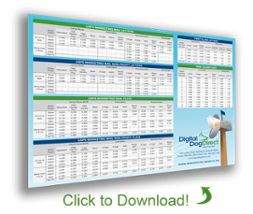
As a business owner, you want to do everything you can to market your business and get the most for your advertising dollars; the last thing you want to do is send out a bunch of mailers only to end up with no responses. Direct mail marketing can include such things as postcards, catalogs, sales letters, brochures or specialty print items. However, not all printed marketing materials are created equal. That’s why you need to ensure that your materials are unique, high quality, and engaging, so that you capture your audience’s attention and encourage them to learn more about your organization.
If you are not getting good response rates from your direct marketing efforts, there are a few print mail tips and techniques that you can use to help maximize your campaigns. Regardless of whether you are looking to draw previous customers back to your business or attract a new crowd of clients, it all starts by keeping a few simple techniques and tips in mind.
Determine what format is going to work the best.
The first step in starting a direct mail campaign is to look at all of the different options available. Each type of mail will have its own unique advantage over the others, which is why you need to spend time going through all available options before deciding on which format (or mix of formats) you want to use.
Some examples include:
- Postcards – A postcard marketing campaign can be very effective, and economical. If you are looking to entice viewers with an awesome offer requiring them to visit your website or call your store, postcards tend to be ideal. In fact, more than half of all individuals end up reading the postcards that come in the mail to them.
- Standard Letters – These letters are often folded and sent to prospects to get them to take notice. The level of personalization is what makes them stand out. Consider letters when your message is more personal in nature; especially when your mailing may contain information that may be considered sensitive.
- Self-Mailers – Similar to postcards, you can mail these pieces without envelopes. They are often folded in half, sealed, and sent through the mail. They are a great option for attention getting, and personalized, designs and can be very cost effective to print.
Identify target demographics and trends for your intended audience.
Regardless of what type of campaign you are looking to run, all successful campaigns start with doing the necessary research to determine what is going to work the best for the market. Learn all you can about the audience you’re targeting, the competition you’re facing and the unique pros and cons that come with your particular initiative. Things like gender, age, income, marital status and ethnic background can all come into play and help you determine who the best individuals to market to are. Review what information you might already have on hand, whether it is studying a past campaign or tapping into a previously compiled mailing list. If you don’t feel confident in your data, hire someone to help you look deeper into your data, or to do the necessary research to help you identify your ideal prospects.
When you have questions, look at the numbers.
Your market research doesn’t mean a whole lot unless you take the time to analyze your data and synthesize it for relevant information. Even if your data set is large and dense, it doesn’t have to be as overwhelming as you might think. Simply start by going over your main goals and focusing on the data that directly answers questions about your main goals. How many total houses are in the area I’m looking to target? By focusing on the most relevant data, you will gain insight into the aspects of your campaign that will make the biggest difference.
Analyze the competition’s current marketing campaign.
Another thing to consider is your competition’s marketing plan. Once you’ve determined who your most relevant competitors are, collect some of their current marketing materials for the sake of comparison. Look for any consistencies that you might find in all of their current marketing campaigns. For example, do they all include a personalized call to action? By analyzing your competition, you will not only get a better sense of what the market looks like, but also get some important insight into what factors you should be considering in your own direct mail campaign.
Create the perfect print design for your mailer.
When it comes to direct mail campaigns, design is crucial. People receive hundreds of pieces of mail every week—what’s going to make your piece stand out? That’s where color schemes, font choices, and packaging all come in to play a very important part of your campaign’s success. To make your piece stand out and command attention, consider going with a personalized design. In fact, it helps to do whatever you can to personalize your mail piece, as this helps with overall branding, as well as making sure your piece immediately communicates who you are and what you have to offer.
By bringing all of the above elements into play when coming up with your direct mail marketing campaign, you can garner the most responses possible. Contact us for additional information on printing your mailers and starting your campaign today.



I feel like post cards are the best option for direct mail. They are so easy to look at and don’t have to be opened, which I feel increases their effectiveness. The only other thing I feel would compare is doing standard letters with hand-addressed envelopes.
I am happy that you pointed out that you need to pick the design of your mailer really carefully. Unless a direct mail flyer is eye catching I normally throw it out. Making sure that people will take the time to look at your marketing does seem really important. It might even be a good idea to print your flyer on a different type of paper.